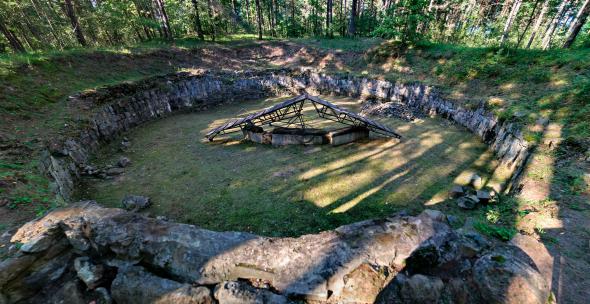Vilnius, the capital city of Lithuania, was known as a center of Jewish intellectual and cultural life before the Holocaust. Not far from the city itself is the Paneriai forest, known in that era as the Ponar. Thanks to new archaeological technology, as of this week the forest is also known as the site at which Jewish prisoners, over the course of three months, used spoons to dig a 112-foot tunnel out of the pit in which they were made to sleep at night—through which 11 managed to survive the war.
The prisoners were in what was known as the Burning Brigade, charged by their Nazi captors with digging up bodies out of mass burial pits and burning corpses as the Soviets advanced. According to an account, one prisoner, Isaac Dogim, recognized the body of his wife by a medallion he had given her and then organized the escape of prisoners who feared that they would join their dead once they had finished burning them. On April 15, 1944, 40 tried to leave. 12 managed to escape alive.
The tunnel is a repudiation of the common conception that victims of the Holocaust made no attempt to resist. According to Jon Seligan, an archaeologist who works with Israel’s antiquities authority and participated in the project through which the tunnel was discovered, it is also “a little glimmer of hope within the dark hole of Ponar. … The tunnel shows that even when the time was so black, there was yearning for life within that.”
One challenge of archaeology is to keep history’s excavation to threaten its preservation. It was a task particularly charged in Ponar, known, according to team member and archaeologist Richard Freund, as “ground zero for the Holocaust” (the mass pits pre-dated the gas chambers). It’s no meager feat—according to Scott Branting, assistant professor of anthropology at the University of Central Florida, “archaeology is a fundamentally destructive science.” But this expedition—completed by archaeologists, as well as scientists and Jewish historians, from Canada, Israel, Lithuania, and the United States—shows how technology can be used to uncover the past without disturbing it. By using electrical resistivity tomography, or ground-scanning technology, the team (which, last year, used ground-penetrating radar to uncover the Great Synagogue of Vilna, destroyed by Nazis and Soviets alike) was able to map the path of the tunnel without disturbing any human remains at the site.
In 2013, Sarah Parcak wrote in Future Tense that thanks to technology, “today is the most exciting time in history to be an archaeologist.” Parcak herself works in space archaeology, which she defined as “the use of space- and air-based sensor systems to discover ancient settlements, cultural remains, and natural features (like relic river courses) otherwise invisible to the naked eye, or hidden due to vegetation and water. Space archaeology has been used in Egypt to show ancient settlements and tombs. It’s shown hundreds of new structures at the Mayan site of Caracol and thousands of what were unknown settlements in Syria. It’s allowed archaeologists to map looting from space. Satellite data let archaeologists to monitor damage to sites (such as in areas controlled by ISIS) and, where intervention is not possible, scanning and digitization technologies have let them make digital reproductions.
And, this week, technology let a team simultaneously uncover and respect the memory of individuals who couldn’t see light at the end of their tunnel—and so, with their very lives at stake, created one for themselves.
